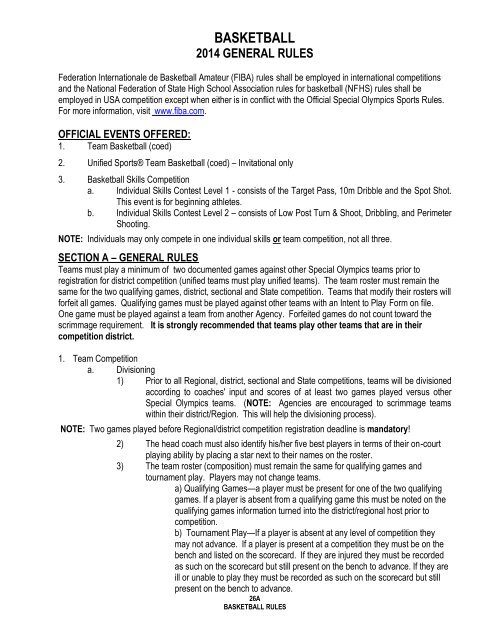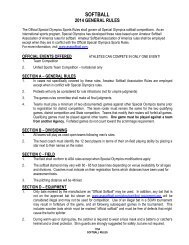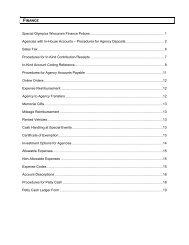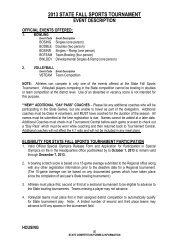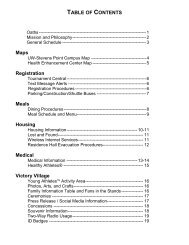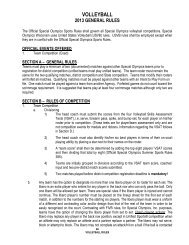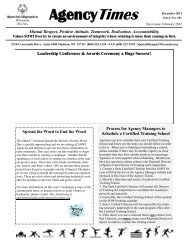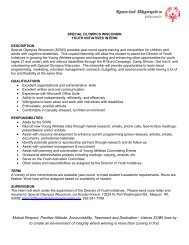BASKETBALL - Special Olympics Wisconsin
BASKETBALL - Special Olympics Wisconsin
BASKETBALL - Special Olympics Wisconsin
Create successful ePaper yourself
Turn your PDF publications into a flip-book with our unique Google optimized e-Paper software.
<strong>BASKETBALL</strong><br />
2014 GENERAL RULES<br />
Federation Internationale de Basketball Amateur (FIBA) rules shall be employed in international competitions<br />
and the National Federation of State High School Association rules for basketball (NFHS) rules shall be<br />
employed in USA competition except when either is in conflict with the Official <strong>Special</strong> <strong>Olympics</strong> Sports Rules.<br />
For more information, visit www.fiba.com.<br />
OFFICIAL EVENTS OFFERED:<br />
1. Team Basketball (coed)<br />
2. Unified Sports® Team Basketball (coed) – Invitational only<br />
3. Basketball Skills Competition<br />
a. Individual Skills Contest Level 1 - consists of the Target Pass, 10m Dribble and the Spot Shot.<br />
This event is for beginning athletes.<br />
b. Individual Skills Contest Level 2 – consists of Low Post Turn & Shoot, Dribbling, and Perimeter<br />
Shooting.<br />
NOTE: Individuals may only compete in one individual skills or team competition, not all three.<br />
SECTION A – GENERAL RULES<br />
Teams must play a minimum of two documented games against other <strong>Special</strong> <strong>Olympics</strong> teams prior to<br />
registration for district competition (unified teams must play unified teams). The team roster must remain the<br />
same for the two qualifying games, district, sectional and State competition. Teams that modify their rosters will<br />
forfeit all games. Qualifying games must be played against other teams with an Intent to Play Form on file.<br />
One game must be played against a team from another Agency. Forfeited games do not count toward the<br />
scrimmage requirement. It is strongly recommended that teams play other teams that are in their<br />
competition district.<br />
1. Team Competition<br />
a. Divisioning<br />
1) Prior to all Regional, district, sectional and State competitions, teams will be divisioned<br />
according to coaches' input and scores of at least two games played versus other<br />
<strong>Special</strong> <strong>Olympics</strong> teams. (NOTE: Agencies are encouraged to scrimmage teams<br />
within their district/Region. This will help the divisioning process).<br />
NOTE: Two games played before Regional/district competition registration deadline is mandatory!<br />
2) The head coach must also identify his/her five best players in terms of their on-court<br />
playing ability by placing a star next to their names on the roster.<br />
3) The team roster (composition) must remain the same for qualifying games and<br />
tournament play. Players may not change teams.<br />
a) Qualifying Games—a player must be present for one of the two qualifying<br />
games. If a player is absent from a qualifying game this must be noted on the<br />
qualifying games information turned into the district/regional host prior to<br />
competition.<br />
b) Tournament Play—If a player is absent at any level of competition they<br />
may not advance. If a player is present at a competition they must be on the<br />
bench and listed on the scorecard. If they are injured they must be recorded<br />
as such on the scorecard but still present on the bench to advance. If they are<br />
ill or unable to play they must be recorded as such on the scorecard but still<br />
present on the bench to advance.<br />
26A<br />
<strong>BASKETBALL</strong> RULES
. Modifications<br />
1) A game will consist of four periods, each six minutes long (clock will be stopped in<br />
accordance to WIAA Rules).<br />
2) A player may take two steps beyond what is allowable; however, if the player scores,<br />
"travels," or escapes the defense as a result of these extra steps, an advantage has<br />
been gained. A violation is called immediately.<br />
3) While a game is in progress, coaches are to remain in their team's bench area. At the<br />
discretion of the official, a coach may be required to sit for the duration of the game in<br />
accordance with NFHS rules. Each team shall be allowed a maximum of three<br />
coaches on their bench during games. Only coaches that are listed on the team’s<br />
registration form are allowed to sit in the bench area. Only athletes with valid medicals<br />
are allowed. Athletes not listed on the roster may not sit on the bench unless they are<br />
an official athlete-as-coach. *See ALPs section Athletes-as-Coaches Program of the<br />
Agency Manager’s Handbook.<br />
4) The three-second rule restriction is in force when team control exists in the opponents'<br />
front court. (NOTE: in FIBA rules, a team shoots at its opponent’s basket...thus the<br />
opponent’s front court.)<br />
5) The free throw shooter shall release the ball within 10 seconds from the time it is<br />
placed at the shooters disposal by one of the officials.<br />
6) If overtime is required due to a tie at the end of regulation play, play shall continue<br />
without change of baskets. A one minute intermission will follow regulation play and<br />
each overtime period. The amount of time for an overtime period is three minutes.<br />
Each overtime period will begin with a jump ball.<br />
c. Equipment<br />
1) <strong>Special</strong> <strong>Olympics</strong> Basketball requires the use of NFHS standard basketball equipment<br />
including the regulation men’s basketball, baskets and basket heights.<br />
The playing court shall be limited by the boundary line, consisting of the end-lines and<br />
the sidelines. These lines are not part of the playing court. Any obstruction including<br />
seated team bench personnel shall be a minimum of three feet from the playing court.<br />
Obstruction also includes misc. seating for spectators or other personnel.<br />
2) Uniform/Apparel<br />
All players must wear basketball attire with identifying numbers and flat rubber sole<br />
athletic shoes.<br />
a) Team uniform shirts and shorts must be identical in trim color and style.<br />
b) Undershirts, if worn, must match the color of the body of the uniform (not the<br />
trim) and must be identical in color. Undershirts may be worn by some or all<br />
of the players, and may be short sleeve or tank top (no cut or ragged edges<br />
are allowed).<br />
NOTE: Players with illegal uniforms will not be allowed to play. Players with non-matching uniforms<br />
will be penalized accordingly. Legality of a uniform may be determined by the Games Management<br />
Team or by the event coordinator.<br />
c) If a player wears an undergarment that extends below the bottom of the<br />
uniform short, (i.e. compression shorts), the undergarment must be the same<br />
color to the main color of the uniform shorts and end above the knee.<br />
27A<br />
<strong>BASKETBALL</strong> RULES
d) Players on a team must wear matching uniform shorts (identical color, trim<br />
and style – nylon, mesh, etc). The only exception is in the case of medical or<br />
religious reasons. In these cases, the uniform pants or tights must be the<br />
same color and trim as the team uniform short. A <strong>Special</strong> Needs Form must<br />
be sent with the team’s Registration Form by the tournament registration<br />
deadline noting the exception.<br />
e) The shirt numbers shall be at least six inches high on the back and at least<br />
four inches high on the front and not less than ¾ inch in width (taped numbers<br />
or pinnies are not legal in SOWI competition unless pinnies are provided by<br />
tournament hosts due to similarly colored jerseys on two teams). Numbers<br />
are required on the back and front of the uniform.<br />
f) The following numbers are legal: 0, 1, 2, 3, 4, 5, 00, 10, 11, 12, 13, 14, 15,<br />
20, 21, 22, 23, 24, 25, 30, 31, 32, 33, 34, 35, 40, 41, 42, 43, 44, 45, 50, 51,<br />
52, 53, 54, 55. A team roster shall not have both numbers 0 and 00.<br />
g) Head Coverings – In the event an athlete is required by a licensed medical<br />
physician to cover his or her head with a covering or wrap, the physician’s<br />
statement must be on file with SOWI before SOWI can approve a covering or<br />
wrap, which is not abrasive, hard, or dangerous to any other player and which<br />
is attached in such a way that is highly unlikely to come off during play. Head<br />
coverings for religious reasons must be documented with SOWI prior to<br />
district/Regional tournament play and meet the same safety standards as a<br />
medical head covering. The only exception is an athlete may wear a head<br />
band no wider than two inches and made of nonabrasive, unadorned single<br />
colored cloth, elastic, fiber, soft leather or rubber. Rubber/cloth (elastic) bands<br />
may be used to control hair. They do not need to match uniform color.<br />
Sweatbands are also allowed.<br />
h) Proper uniforms and uniform numbering will be enforced! Individuals who do<br />
not adhere to uniform regulations will not be allowed to enter a game.<br />
i) <strong>Special</strong> situations: an accommodation may be made in exceptional situations<br />
such as an athlete with a behavior problem or requiring a 4XL size. Teams<br />
wishing to apply for an exception must contact the host tournament<br />
coordinator and receive approval in advance of the registration deadline. An<br />
athlete may be allowed to wear a uniform that is not identical; however they<br />
must wear one of similar color. Exceptions requested on site will not be<br />
granted.<br />
NOTE: Failure to comply with team uniform rules will cause the team to forfeit its game if the player with the<br />
uniform violation takes the team below the legal number of players to start the game. A team may use<br />
the time between games to rectify a uniform violation. If they do not, and the player(s) with the violation<br />
takes the team below the legal number of players to start the second game, that game will also be a<br />
forfeit.<br />
3) Athletes may not wear or use equipment which may be dangerous or confusing to<br />
other players. Examples of illegal items include but are not limited to: wheelchairs,<br />
crutches, or other items considered illegal by the NFHS including jewelry.<br />
d. Officials and their Duties<br />
1) Officials conduct the game in accordance with the rules.<br />
28A<br />
<strong>BASKETBALL</strong> RULES
NOTE: Violations will be called (including double dribble).<br />
2) Officials shall have full authority to interpret rules. For further questions, the<br />
tournament rules committee shall be consulted.<br />
3) Officials shall have the power to make all decisions on any points not specifically<br />
covered in the rules.<br />
4) The one-and-one, or bonus free throw(s), will be shot with the seventh team foul of<br />
each half and the double bonus, or two free throws on the tenth foul of each half.<br />
5) The game will consist of four periods each six minutes long.<br />
6) A team will be entitled to three timeout periods of 60 seconds each and two 30-<br />
second timeout periods during the game. Each team is entitled to one additional<br />
timeout during each extra period.<br />
7) Half time will be a minimum of five minutes and a maximum of 10 minutes with one<br />
minute breaks between quarters at the discretion of Games Management Team and/or<br />
officials.<br />
8) Each team will be allowed 10 minutes after the scheduled game time to take the court.<br />
If a team is not ready to take the court at the end of 10 minutes, the game will be<br />
forfeited.<br />
e. Players and Substitutes<br />
1) Each team shall consist of at least five players, with a maximum roster of 12 players.<br />
2) A team must have five players to start a game. Failure to start five players will result in<br />
a forfeit.<br />
3) If during competition, a team falls below five players due to injury or player<br />
disqualification, the team must maintain all members on the court. No team will be<br />
allowed to pull a player to act as a sub. The minimum number of players any one<br />
team can have is three. If a team has under three players due to injury or player<br />
disqualification, the team will be forced to forfeit, regardless of time left on the game<br />
clock.<br />
4) Substitutions may be made any time the ball is dead and the clock is stopped.<br />
Substitutes must report to the scorer who will notify the referee of substitutions.<br />
5) An athlete may participate on only one SOWI team in a basketball season. If the<br />
athlete plays on a second team for whatever reason, those games will not count<br />
toward qualifying games.<br />
f. Scoring<br />
1) Scoring will follow NFHS rules.<br />
2) If the score is tied at the end of the second half, play shall continue without change of<br />
baskets for extra periods of three minutes until the score is no longer tied.<br />
3) Scorebook procedures (see example in this section.)<br />
2. Unified Sports® Team Basketball<br />
a. The roster shall contain a proportionate number of athletes and partners according to the<br />
Unified Rules Section of the Competition Guide.<br />
29A<br />
<strong>BASKETBALL</strong> RULES
. During competition, the line up shall never exceed three athletes and two partners at any time.<br />
If at any time this ratio is not adhered to, the offending team will automatically forfeit the game.<br />
c. Each team will have an adult non-playing coach responsible for the line-up and the conduct of<br />
the team during competition.<br />
d. In the game, partners must not score more than 75% of the team’s total points, and the<br />
athletes must not score more than 75% of the teams’ total points. Thus, the athletes as a<br />
group, and the partners as a group, must score at least 25% of the total points each. Failure to<br />
adhere to the required ratio results in a forfeit. Process for contesting this rule: 1) Within five<br />
minutes of the conclusion of the game, the team challenging the 75% rule must inform the<br />
scorer’s table they wish to have the final score checked to see if a team is in compliance with<br />
the 75% rule. 2) The score keeper, with assistance from the court monitor, shall check both<br />
teams’ scores to ensure that they are in compliance with the 75% rule. 3) If either team is<br />
found to be in violation of the 75% rule, the offending team(s) will forfeit the game in question.<br />
4) If both are found to be in violation of the 75% rule, both teams will forfeit the game, and<br />
both teams will be given a loss. 5) If neither team challenges the 75% rule within the allotted<br />
five-minute period immediately following the game, the results of the game shall stand as final<br />
and no further challenge of the 75% rule shall be acted upon.<br />
3. Basketball Skills Assessment Tests (BSAT)<br />
a. BSAT – Dribbling<br />
1) Set-Up: An area of the basketball court (preferably along a side line or down the<br />
center line), six cones, floor tape, and four basketballs (one that the athlete is provided<br />
initially, two others that are for back-up in case the basketball bounces away, and one<br />
more to continue the test).<br />
2) Test: (Time: 60 seconds for one trial.) A player is instructed to dribble the ball while<br />
passing alternately to the right and to the left of six obstacles placed in a line, 2m (6' 6<br />
3/4") apart, on a 12m course. The player can start to the right or to the left of the first<br />
obstacle but must pass each obstacle alternately, thereafter. When the last obstacle is<br />
passed and the FINISH line reached, the player puts the ball down, sprints back to the<br />
START for the next ball, and repeats the slalom. The player continues until 60<br />
seconds have elapsed. If a player loses control of the ball, the clock continues to run.<br />
The player recovers the ball or picks up the nearest back-up ball and may re-enter at<br />
any point along the course.<br />
30A<br />
<strong>BASKETBALL</strong> RULES
3) Scoring: One point is awarded each time a cone is passed. For example, if the player<br />
successfully dribbles the ball from the starting line, weaves in and out through the<br />
entire obstacle course one time, and places the ball down at the finish line, a score of<br />
five has been achieved. The player must use legal dribbles and must have control of<br />
the ball in order to get credit for that cone successfully passed. The player must put<br />
the ball down and bring it to a controlled stop upon reaching the finish line. Failure to<br />
do so will result in the loss of a point. The player's score is how many cones he/she<br />
successfully passes in 60 seconds.<br />
4) Staging: Volunteers administer the test and are not to interfere with any player who is<br />
performing the test. Volunteer A will instruct the group doing this particular test while<br />
Volunteer B demonstrates the actual test. Volunteer A will give a basketball to the<br />
player who will take the test, ask him/her if ready, will then say, "Ready, Go," and will<br />
count how many cones the player passes in 60 seconds. Volunteer B and C who are<br />
standing behind the extra balls will retrieve and replace the basketball whenever it<br />
goes out of play. Volunteer D will time and record the athlete's score. Each volunteer<br />
is to administer the test and manage their area only.<br />
b. BSAT – Perimeter Shooting<br />
1) Set-Up: A goal, the official NGB free throw lane, floor tape, and two basketballs (one<br />
that the athlete is provided initially, another that is for back-up in case the basketball<br />
rebounds away).<br />
2) Test: (Time: one trial of one minute.) A player stands at the juncture of the free<br />
throw line and lane, either to the left or right. The player dribbles toward the goal and<br />
attempts a field goal of his/her choice outside the 2.75m (9') arc. This attempt must<br />
be taken anywhere outside the 2.75m arc marked off by a dotted line. (This arc<br />
intersects with the bottom of the free throw restraining circle and is measured by<br />
standing centered directly below the backboard.) The player then rebounds the<br />
basketball (made or missed shot) and dribbles anywhere outside the arc before<br />
attempting another field goal. (A player must return to the spot of a rebounded shot<br />
and dribble outside of the arc if he/she did not dribble out originally.) The player shall<br />
make as many field goals as described above in one, one minute trial.<br />
3) Scoring: Two points are awarded for each field goal made within the one minute trial.<br />
4) Staging: Volunteers administer the test and are not to interfere with any player who is<br />
performing the test. Volunteer A will instruct the group doing this particular test while<br />
31A<br />
<strong>BASKETBALL</strong> RULES
Volunteer B demonstrates the actual test. Volunteer A will give a basketball to the<br />
player who will take the test, ask him/her if ready, and then say, "Ready, Go," and will<br />
count how many field goals the player makes in one minute. Volunteer B who is<br />
standing behind the extra ball will retrieve and replace the basketball whenever it goes<br />
out of play. Volunteer C will time and record the athlete's score. Each volunteer is to<br />
administer the test and manage their area only.<br />
c. FINAL BSAT SCORING: Total the final score for each of the two BSAT Skill Tests for each<br />
player.<br />
32A<br />
<strong>BASKETBALL</strong> RULES
NAME<br />
<strong>BASKETBALL</strong> SKILLS ASSESSMENT TEST SCORE SHEET<br />
DRIBBLING<br />
(# of cones passed)<br />
PERIMETER SHOOTING<br />
(# of shots made x 2)<br />
TRIAL 1 TRIAL 1<br />
FINAL TOTAL<br />
1<br />
2<br />
3<br />
4<br />
5<br />
6<br />
7<br />
8<br />
9<br />
10<br />
11<br />
12<br />
Sum of top seven athletes” total scores divided by seven = (Team Score)*<br />
*NOTE: If a team consists of five or six players, divide the total scores by the actual number of players. No team may consist of less than five players.<br />
33A<br />
<strong>BASKETBALL</strong> RULES


